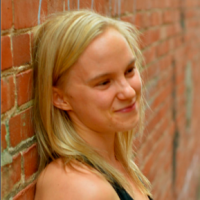(This post was originally featured on YogaModern.com,
where Chelsea Roff is Assistant Editor and a regular contributor.
Second in a two-part series, part 1 here.)
Finding the Sacred in the Shadow
by Chelsea Roff
“By cultivating attitudes of friendliness toward the happy, compassion for the unhappy, delight in the virtuous, and disregard toward the wicked, the mind-stuff retains its undisturbed calmness.” – Yoga Sutra 1.33
My first encounter Yoga Sutra 1.33 conjured up images of Gandhi-like figures feeding hungry people in the streets. I pictured Mother Teresas rubbing the feet of much-maligned criminals in dirty prisons and imagined myself hugging the “wicked” little brat—ahem, I mean insecure child—who had made my life a living hell in first grade. I assumed Patanjali’s message pertained solely to how we relate to others. Love your enemy. Turn the other cheek. Be a do-gooder. Those notions were easy to accept. Who doesn’t want world peace?
Now, though, I’ve discovered a few more strands of insight hanging from the split end of Patanjali’s thread (the word sutra literally translates as “thread” from Sanskrit). It astounds me that such a short, seemingly simple phrase can pack in so much content—so much stuff to unravel—within just a couple dozen words. The more I’ve tugged, untangled the words of wisdom woven into Sutra 1.33… the more difficult this teaching has become.
I was very fortunate recently to have had the privilege of attending a leadership training led by the three profoundly inspiring women (Seane Corn, Suzanne Sterling, and Hala Khouri) behind a yoga-service organization, Off The Mat Into The World. That weeklong intensive (a description it most certainly earned) was one of the most transformative and impactful experiences of my life. It was an opportunity for me to dig deep, gain new perspective on my life’s journey, and explore how the most painful experiences of my life may very well hold the key to unlocking my greatest potential to serve others. And it was during that training that I gained the clarity to see Sutra 1.33 in an entirely different way.
On one particularly intense day during the training, one of the teachers uttered a few words that deeply resonated with me. Speaking on how we are to find our purpose in the world, Seane spoke with unshakable conviction: It’s your shadow, she said, that reveals the “power of your light, the depths of your beauty, and your capacity for empathy.” I remember feeling tingles shoot up my spine as the significance of her words sunk through to a deeper, more subtle layer of my understanding. I quickly scrawled the gist of it down in my journal to return to later. Little did I know that statement would become a powerful tool for carving out a new path forward in my life.
When I got home, it was a challenge to shift back into the daily grind of my “real life” and integrate all I’d stepped into during my training in Denver. One night at a weekly yoga sutras discussion group I attend, the relevance of Seane’s words finally became clear. As I conversed with the group about the relevance of Sutra 1.33 for our day-to-day lives, a lightbulb suddenly flickered on. I realized that this sutra was asking me to let go of my self- judgments and allow acceptance to transform the so-called “shadow” parts of myself into light. Both Seane and Patanjali were saying the same thing. Peace—both for the individual and the collective—comes from cultivating unconditional love and acceptance for the deepest, darkest parts of ourselves… in effect, finding the Sacred in the Shadow.
“The wicked” Patanjali speaks of is no longer the bully that tormented me in elementary school; rather, it’s the loathsome aspect of my personality I keep hidden in the gallows of my soul. It’s the wicked witch that torments my own heart from within, a being I despise much more than people I know who are cruel or non-virtuous in life. Can I cultivate an attitude of non-judgment toward the darker aspects of myself? Now, that’s a bit more difficult. But it’s in learning to do that that I find my greatest capacity to serve others. For if I can offer unconditional love to the villains I harbor within—well, hell—the murderer, the rapist, and even Hitler become forgivable as well.
Now, I no longer read the Sutras as a sort of distant and esoteric dictum on one’s philosophical approach to life. Sutra 1.33 has become a practical, surprisingly difficult teaching on how to more compassionately relate to myself and be of greatest service to others. I’d like to share an excerpt from one of the journal entries I wrote while at the Off the Mat training. I think it pretty well sums up the new way I’ve come to relate to the Sutras, to Seva, and to the Sacred in myself:
“In order to embody the Light of Love, I must also integrate the darkness of the shadow. It was in my agony that I most deeply touched the vulnerability and tenderness of my heart, and through that vulnerability I tap into my shared connection with all living beings.”










Read 3 comments and reply